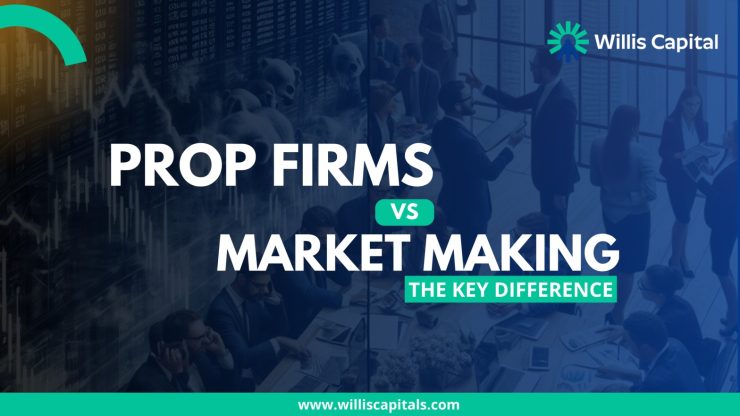If you have been researching trading, you have probably heard of “prop trading firms” and “market making.”
Even though they are both very important to the financial markets, they function differently and have different goals.
We’ll compare the characteristics, tactics, and operations of market-making and prop trading companies in this comprehensive guide to help you grasp the main distinctions and make wise trading selections.
What Is Proprietary Trading (Prop Trading)?
Using a company’s funds to trade financial products including stocks, bonds, currencies, and cryptocurrencies to make money is known as proprietary trading or prop trading.
Essentially, prop trading companies do not execute trades on themselves; instead, they use their capital to participate in the financial markets by giving funded trading accounts to experienced and tested traders to trade on their behalf.
Prop traders use the firm’s trading platforms, resources, and their unique trading strategies to make transactions.
Typically, prop traders work for prop trading firms.
Key Aspects Of Prop Trading
There a 3 key differences:
Use of Firm Capital:
To finance trading operations, prop trading companies take money out of their own pockets to fund traders.
Prop trading is differentiated from typical retail trading by this, as individual traders use their own money.
Proprietary Trading methods:
Directional trading, arbitrage, market-making, algorithmic trading, and quantitative trading are just a few of the trading methods used by prop traders.
These tactics are frequently created internally and are designed to take advantage of price fluctuations and market inefficiencies.
Risk and Reward Sharing:
The gains made by prop traders are divided between them and the company.
The division of profits is decided by profit-sharing agreements between traders and the firm; traders normally receive a portion of the profits they make.
The upside of this however is that the losses made on the live account are borne by the prop firms and not by the traders.
This means if a trader loses an account due to multiple losses, he or she does not have to pay the firm any money to make up for the losses incurred.
What Is Market Making?
Market making is a trading method wherein buy and sell prices for a certain asset are regularly quoted.
The goal of this approach is to facilitate trade and provide liquidity to the market.
Market makers, sometimes referred to as liquidity providers, guarantee that there is a ready market for assets by being prepared to purchase and sell securities at quoted prices.
The difference between the asking and bidding prices for an item is known as the bid-ask spread, and it is this spread that makes market makers money.
Market makers are usually brokerage houses that offer investors trading services to maintain the liquidity of the financial markets.
An individual trader, usually referred to as a local, can also function as a market maker.
Because of the magnitude of securities required to support the volume of purchases and sells, the great majority of market makers operate for huge institutions.
Every market maker shows bids and offers for a predetermined quantity of shares.
The market maker promptly sells off their position of shares from their inventory as soon as they receive an order from a buyer.
They can finish the order as a result.
Key Aspects Of Market Making
1. Providing Liquidity:
By offering to buy and sell securities at specified prices, market makers play a critical role in supplying liquidity to the financial markets.
This makes it possible for transactions to be completed swiftly and effectively between buyers and sellers without having a big effect on the market price.
2. Capturing the Spread:
The difference between the prices at which market makers purchase and sell securities is known as the bid-ask spread, and it is this gap that gives them profits.
Their goal is to purchase assets at a discount and resell them for a profit by keeping the difference between the two prices.
3. Managing Inventory and Risk:
To balance supply and demand and reduce exposure to market risk, market makers must efficiently manage their inventory of securities.
They might dynamically modify their price and quotation tactics in response to shifts in the order flow and state of the market.
Market making plays a crucial role in preserving market liquidity and promoting effective price discovery in a variety of financial markets, such as foreign exchange (forex), stocks, options, and futures.
Key Differences Between Prop Firms And Market-Making
| NOs | Prop Trading Firms | Market Making | |
| 1 | Purpose |
|
|
| 2 | Capital and Risk |
|
|
| 3 | Trading Strategies |
|
|
| 4 | Trading Frequency and Holding Periods |
|
|
| 5 | Capital Allocation and Leverage |
|
|
| 6 | Profit Structure and Revenue Sources |
|
|
Conclusion
In conclusion, market-making and prop trading companies both have significant roles in the financial markets, but they have different goals, approaches, and risk tolerances.
Market makers give liquidity and ease trade by providing prices for financial assets, while prop trading businesses concentrate on making money through active trading and speculation.
Traders and investors can make better decisions and negotiate the intricacies of the financial markets by being aware of the differences between these two organizations.


